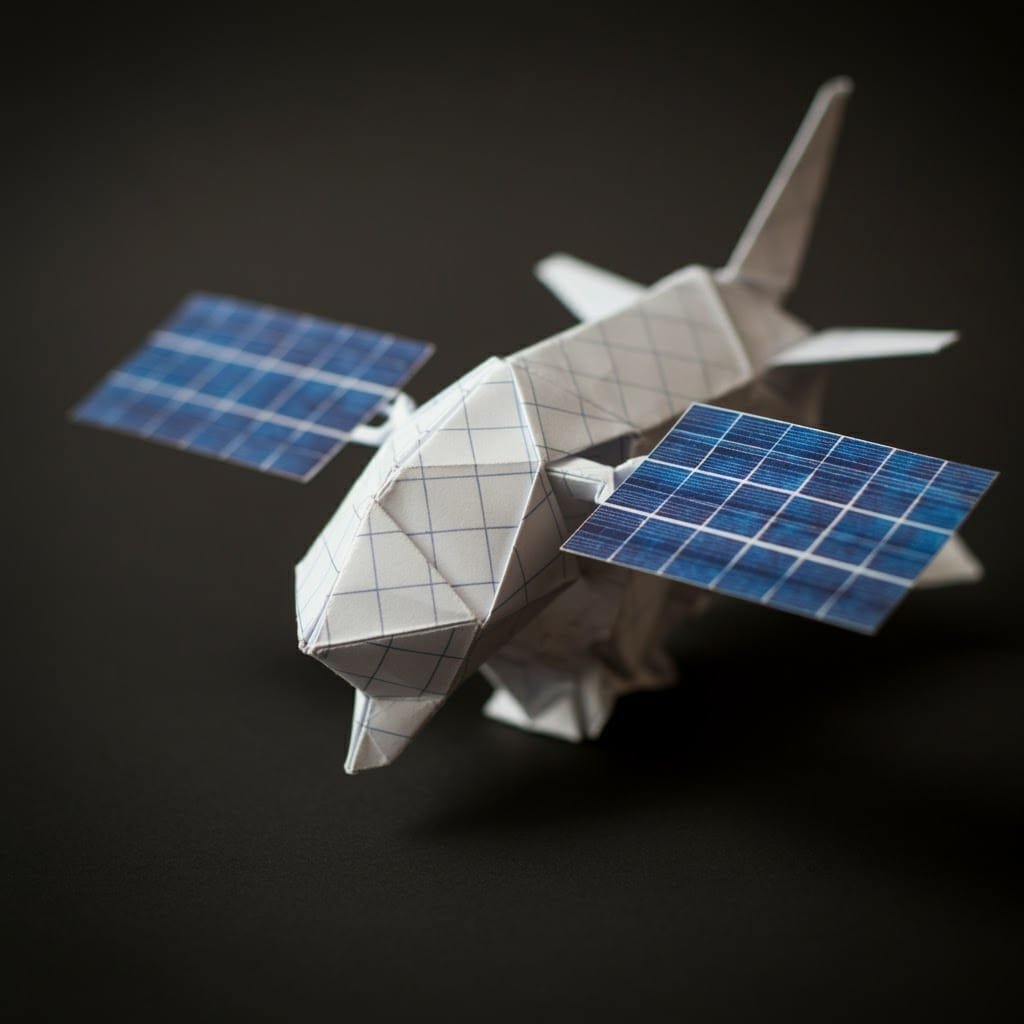Your cart is currently empty!
Stay in Touch!
Get updates about new artwork and upcoming events.
Get updates about new artwork and upcoming events.
—
by
Origami, traditionally recognized as the Japanese art of paper folding, has made its way into aerospace engineering in revolutionary ways. While origami artists have long used intricate folds to create beautiful, precise forms, engineers have adapted these folding techniques to solve challenges in space exploration. Space missions demand compact designs for large, functional structures that can withstand the extreme environments of space and deploy without failure. Origami-inspired folding offers an elegant solution, bridging centuries-old craftsmanship with modern space science.


This blog delves into origami’s practical applications in space missions, highlighting key space innovations that have evolved from traditional folding techniques. We’ll explore how origami influences structural designs for solar arrays, sunshields, fuel bladders, and more, making space exploration more efficient and feasible.
Solar power is a critical energy source for spacecraft, but efficient solar panel design is complicated by limited space in launch vehicles. Thanks to origami, engineers can fold large solar arrays compactly, deploy them reliably, and ensure optimal energy production once in orbit.
The Miura-ori fold, a pattern with origins in Japan, was first adapted for satellite solar panels in 1995. Named after Japanese astrophysicist Koryo Miura, this technique is characterized by a series of zigzag folds that allow a flat surface to collapse into a compact unit. Once in orbit, panels can unfold in a smooth, rapid motion, transforming a small package into a large solar array.
This design has reduced both storage needs and deployment risks, as the folded panels are protected from launch forces, only unfolding when safely in space. The Miura-ori fold’s predictability and compactness have set a new standard in solar array design, helping increase energy supply without increasing spacecraft weight or volume.
While the Miura-ori fold paved the way, advancements continue with patterns like the Origami Flasher. This design takes compactness to a new level by reducing solar array size by up to 10 times. The Flasher fold, named for its visual resemblance to flashing lights as it unfurls, creates intricate folds that pack large panels into even smaller spaces. Its compact storage capabilities are complemented by a robust structure that protects the panels during launch and provides reliable unfolding, meeting the strict requirements of aerospace engineering for durability and consistency.
One of the most iconic uses of origami in aerospace engineering is the James Webb Space Telescope (JWST), which uses origami-inspired folding techniques for both its mirror and its massive sunshield.
The JWST’s primary mirror measures 6.5 meters in diameter and consists of 18 hexagonal segments made from beryllium. To fit inside the launch vehicle, these segments were meticulously folded in an origami-inspired configuration and only unfolded once in space. This precise engineering allows the telescope to maintain optimal reflective properties, essential for observing faint, distant galaxies.
Equally impressive is JWST’s 20-meter sunshield, an expansive, five-layered shield that protects the telescope from solar heat. Built using lightweight, temperature-resistant materials, the sunshield employs origami-inspired folding to fit compactly within the spacecraft during launch. In space, it unfolds to provide critical thermal protection, allowing the telescope’s instruments to operate at temperatures as low as -233 degrees Celsius. This is an extraordinary example of how origami can meet the demanding specifications of thermal engineering, packaging, and deployment.
The Starshade project embodies another sophisticated application of origami in aerospace. This proposed structure is designed to assist telescopes in detecting distant exoplanets by blocking starlight from nearby stars.
The Starshade is designed to unfold in space, creating a flat disk with petal-like structures that blocks starlight from a star, effectively creating an artificial eclipse. This allows telescopes to observe faint planets that would otherwise be obscured by bright stellar light. The structure’s diameter, approximately the size of a baseball diamond, is achieved by compactly folding it within a spacecraft, following a precise origami-inspired pattern.
The Starshade requires extreme precision in both folding and deployment to ensure it blocks starlight accurately. Engineers are experimenting with various materials and origami patterns to achieve the Starshade’s unique disk shape and precise petal structures, all while minimizing storage space. This project exemplifies how origami principles can be applied beyond physical efficiency, influencing precision design and enhancing our ability to explore other worlds.
Solar sails represent another revolutionary application of origami in space, where they use sunlight as a propulsion method. These sails must be lightweight and capable of unfurling over large areas, and origami folding techniques are perfect for achieving these requirements.
Solar sails must fit compactly into a spacecraft but expand to considerable sizes—some up to 20×20 meters—once deployed. The expansive surface captures photons from the sun, creating a gentle, continuous thrust that propels the spacecraft without fuel. Origami techniques, such as radial folding patterns, are used to fold these large sails tightly, ensuring they occupy minimal space during launch.
By reducing the need for fuel, solar sails allow for longer missions and extended exploration. Origami’s contribution to this technology demonstrates its impact on sustainable space travel, paving the way for journeys to distant planets and deep-space destinations.
Origami’s influence on space travel extends to habitats designed for future extraterrestrial exploration. As we consider the possibility of setting up permanent or semi-permanent bases on Mars or the Moon, compact, deployable structures become essential.
Engineers are studying origami-inspired designs for compact living spaces that can be transported on spacecraft, then deployed as functional habitats on Mars. These foldable buildings leverage the compactness and strength of origami folds, enabling structures to be stowed in spacecraft and assembled upon landing. Such designs could serve as research labs, storage units, or crew quarters, providing protection and functionality in challenging extraterrestrial environments.
Mars habitats must endure extreme temperature fluctuations, radiation, and other environmental hazards. Using origami folding techniques enables engineers to design structures with natural stiffness and resilience, providing greater stability and material efficiency. By incorporating origami principles, these habitats can achieve structural durability while maintaining compactness and portability.
Fuel storage is another area where origami principles have offered innovative solutions. Traditional fuel tanks struggle with space constraints and extreme temperature fluctuations, which can compromise fuel stability. Scientists at Washington State University have developed an origami-inspired folded plastic bladder that solves many of these challenges.
Origami folds in the plastic bladder allow it to expand and contract without breaking, a feature essential for maintaining fuel integrity in the harsh environment of space. This flexibility and durability make the bladder an ideal solution for storing fuel on spacecraft, as it minimizes risk and maximizes available space.
Beyond fuel storage, origami’s principles can apply to various types of containment systems in space. As engineers refine these folding techniques, we may see origami-inspired designs in life-support systems, water storage, and other critical spacecraft components, all benefiting from origami’s adaptability.
The use of origami in space technology is still evolving. Researchers and engineers are pushing the boundaries of this ancient art, applying it to create more efficient, resilient, and innovative space structures. Among them, Stanford aerospace engineer Manan Arya is exploring “non-flat” origami to develop corrugated structures that break traditional folding conventions. These designs could open new possibilities in aerospace engineering, further expanding origami’s applications in both structure and function.
From foldable habitats on Mars to flexible, origami-inspired shields for asteroid impact protection, the future of origami in aerospace holds exciting potential. With each new project, origami continues to offer solutions that balance compactness, strength, and precision, embodying the innovative spirit needed for space exploration.


Origami’s principles have transformed from art to engineering marvels, making a profound impact on aerospace technology. Its compact and reliable folding methods have solved some of the most complex challenges in space exploration, providing practical solutions for energy, protection, storage, and habitat needs. For art collectors and interior designers, origami’s journey into aerospace engineering offers a compelling example of how ancient creative practices can inspire groundbreaking innovation. As we look to the future, origami’s role in space exploration may only grow, continuing to shape the next frontier of human discovery.